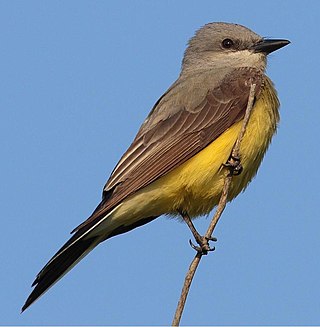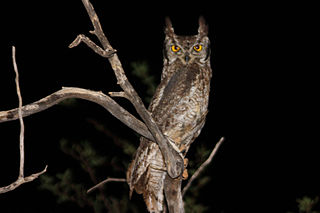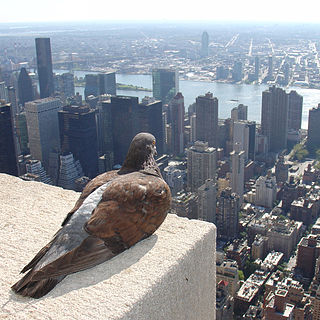
Barry (died August 6, 2021) was a female barred owl that lived in Central Park in New York City for about ten months.

Barry (died August 6, 2021) was a female barred owl that lived in Central Park in New York City for about ten months.
This section relies largely or entirely upon a single source .(February 2024) |
Barry was first spotted on October 9, 2020, by a group of birders. Barry quickly became a desired sighting for birders and regular park visitors. Those who wanted to see Barry would go to the Loch, a creek in the northwest of the park. [1] Barry's observers were eventually able to determine she was a female owl from the pitch of her hoot; however, the name "Barry" that she was originally given stuck. Following her death, the Wild Bird Fund estimated that she was approximately a year old from looking at the colors of her plumage.
Unlike behavior considered normal for an owl, Barry seemed unbothered by the presence of humans, often perching near paths where her admirers stood.
In April 2021, Barry set the record for the longest stay in Central Park for a barred owl, ultimately choosing it as her home instead of migrating. [1]
Barry was tracked by Manhattan Bird Alert, a feed on Twitter which tracks bird sightings across New York City. If Barry was posted to the feed, dozens of people rushed to the location to see her. [1] Barry had a prolific Twitter presence (run by a fan) that gave a voice to Barry's travels throughout Central Park. Barry's activities when not sleeping included hunting small animals throughout the park and splashing in water on hot days.[ citation needed ]
Barry died on August 6, 2021, as a result of truck collision. [2] [3] [4]
After her death, Barry was memorialized in a vigil on August 9, 2021. It was held under the tree she was most often spotted in near the Central Park Boathouse. [5] Hundreds attended her vigil.
At the time of her death, Barry had a potentially lethal amount of rat poison in her body. This may have impaired her flying ability and prevented her from evading the van that struck her. [6]


Owls are birds from the order Strigiformes, which includes over 200 species of mostly solitary and nocturnal birds of prey typified by an upright stance, a large, broad head, binocular vision, binaural hearing, sharp talons, and feathers adapted for silent flight. Exceptions include the diurnal northern hawk-owl and the gregarious burrowing owl.

The true owls or typical owls are one of the two generally accepted families of owls, the other being the barn owls (Tytonidae). This large family comprises 230 living or recently extinct species in 24 genera. The typical owls have a cosmopolitan distribution and are found on every continent except Antarctica.

The little owl, also known as the owl of Athena or owl of Minerva, is a bird that inhabits much of the temperate and warmer parts of Europe, the Palearctic east to Korea, and North Africa. It was introduced into Britain at the end of the 19th century and into the South Island of New Zealand in the early 20th century.

The blue jay is a passerine bird in the family Corvidae, native to eastern North America. It lives in most of the eastern and central United States; some eastern populations may be migratory. Resident populations are also in Newfoundland, Canada; breeding populations are found across southern Canada. It breeds in both deciduous and coniferous forests, and is common in residential areas. Its coloration is predominantly blue, with a white chest and underparts, and a blue crest; it has a black, U-shaped collar around its neck and a black border behind the crest. Males and females are similar in size and plumage, and plumage does not vary throughout the year. Four subspecies have been recognized.

The eastern bluebird is a small North American migratory thrush found in open woodlands, farmlands, and orchards.

The barred owl, also known as the northern barred owl, striped owl or, more informally, hoot owl or eight-hooter owl, is a North American large species of owl. A member of the true owl family, Strigidae, they belong to the genus Strix, which is also the origin of the family's name under Linnaean taxonomy. Barred owls are largely native to eastern North America, but have expanded their range to the west coast of North America where they are considered invasive. Mature forests are their preferred habitat, but they can also acclimatise to various gradients of open woodlands. Their diet consists mainly of small mammals, but this species is an opportunistic predator and is known to prey upon other small vertebrates such as birds, reptiles, and amphibians, as well as a variety of invertebrates.

The western kingbird is a large tyrant flycatcher found throughout western environments of North America, as far south as Mexico.

The spotted owl is a species of true owl. It is a resident species of old-growth forests in western North America, where it nests in tree hollows, old bird of prey nests, or rock crevices. Nests can be between 12 and 60 metres high and usually contain two eggs. It is a nocturnal owl which feeds on small mammals and birds. Three subspecies are recognized, ranging in distribution from British Columbia to Mexico. The spotted owl is under pressure from habitat destruction throughout its range, and is currently classified as a near-threatened species.

The Staten Island Zoo is an 8-acre (3.2 ha) urban zoo in West New Brighton, Staten Island, New York City. The zoo is open year-round except on Thanksgiving, Christmas, and New Year's Day. It has been accredited by the Association of Zoos and Aquariums (AZA) since 1988.

Rodenticides are chemicals made and sold for the purpose of killing rodents. While commonly referred to as "rat poison", rodenticides are also used to kill mice, woodchucks, chipmunks, porcupines, nutria, beavers, and voles. Despite the crucial roles that rodents play in nature, there are times when they need to be controlled.

Pale Male, or Palemale, was a red-tailed hawk that resided in and near New York City's Central Park from the 1990s until 2023. Birdwatcher and author Marie Winn gave him his name because of the unusually light coloring of his head. He was one of the first red-tailed hawks known to have nested on a building rather than in a tree and is known for establishing a dynasty of urban-dwelling red-tailed hawks.

The northern spotted owl is one of three spotted owl subspecies. A western North American bird in the family Strigidae, genus Strix, it is a medium-sized dark brown owl native to the Pacific Northwest. An important indicator species, the northern spotted owl remains threatened due to continued population decline from human-caused habitat destruction and competition with invasive species, its main competitor being the barred owl.

The spotted eagle-owl, also known as the African spotted eagle-owl and the African eagle-owl, is a medium-sized species of owl, one of the smallest of the eagle owls. Its length is 45 cm (18 in) and its weight is from 454 to 907 grams. It has a 100 to 140 cm wingspan. The facial disk is off-white to pale ochre and the eyes are yellow. It has prominent ear-tufts, and the upper body is dusky brown, the lower parts off-white with brown bars. Prior to 1999 the spotted eagle-owl was considered conspecific with the greyish eagle-owl, but now it is classed as a separate species.

Rats in New York City are widespread, as they are in many densely populated areas. They are considered a cultural symbol of the city. For a long time, the number of rats in New York City was unknown, and a common urban legend declared there were up to five times as many rats as people. However, a 2023 study estimates that there are approximately 3 million rats in New York, which is close to a third of New York's human population.

The Central Park mandarin duck, also known as Mandarin Patinkin or the Hot Duck, is a male mandarin duck seen at the Pond in New York City's Central Park starting in late 2018. His colorful appearance, which contrasted with native waterfowl, combined with his presence far outside of the species' native range of East Asia, led to media attention from late 2018 through 2019. Though he has a band around its leg, his origin is undetermined. His last sighting was in March 2019. In 2021, entertainer Bette Midler published a children's book about him. In 2023, filmmaker Kevin Schreck released a short documentary about the bird, The Duck of New York. The film had its world premiere at the 2023 Coney Island Film Festival.
The Wild Bird Fund is a non-profit animal hospital on the Upper West Side of Manhattan in New York City. It is the city's first and only wild animal hospital.
The year 2021 in birding and ornithology.

New York City is home to a large birding community and diverse range of bird species. Though it is the most populous and most densely populated city in the United States, NYC is home to a range of ecological habitats and is situated along the Atlantic Flyway, a major route for migrating birds. More than 400 species have been recorded in the city, and their concentration in the city's urban parklands, forests, marshes, and beaches has made birding a popular activity in the city, especially after the start of the COVID-19 pandemic.

Flaco was a male Eurasian eagle-owl who escaped his long-time enclosure at Central Park Zoo in New York City after someone cut the protective netting in February 2023. Flaco subsequently resided in and around Central Park. His escape attracted significant public and press attention, especially as he was of a species not native to North America. There were concerns for his ability to feed himself after being captive for so long, since he had not needed to fly or hunt, but he was seen successfully catching and eating rats a week after his escape. Attempts to recapture Flaco failed, and a petition circulated advocating that he remain free. Zoo officials ceased attempts to recapture him once it became clear he was eating on a regular basis and his flying skills improved.
Gladys was a female Eurasian eagle-owl who escaped after flying off into a tree during a routine exercise and training session at the Minnesota Zoo in Apple Valley, Minnesota in October 2021.